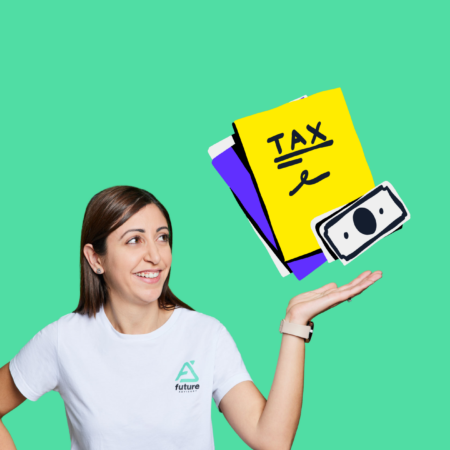What is a Car Fringe Benefit?
Providing company cars to employees? Learn car fringe benefits rules, FBT calculation methods, EV exemptions since 2022, and how to reduce tax liability.
It’s FBT season and the most common fringe benefit we see are cars – so let’s talk about it! If an employer offers an employee a company car for private use, that’s considered a car fringe benefit. Essentially it means that the car is a perk of being an employee, and the taxman is gonna want a slice of that.
Top Highlights:
- A car fringe benefit arises when a business provides a car to an employee (including directors) for private use — and yes, the ATO considers that a taxable perk.
- A car is considered to be used for ‘private use‘ when it is used for personal errands or trips, it is not kept at the business premises, or it is garaged at the employee’s home, even if it is unused.
- Fringe Benefits Tax (FBT) is calculated using either the Statutory Formula Method (based on the car’s base value) or the Operating Cost Method (based on actual running costs and private use percentage).

Car Fringe Benefit Defined: What Does It Mean for Small Businesses?
A car fringe benefit commonly arises when an employer makes a car they own or lease available for the private use of an employee. This applies to business owners as well if they operate through a company or trust and are considered employees themselves (Source: ATO).
A car is deemed available for private use by an employee on any day if it meets one or more of the following conditions:
- Used for Private Purposes: The employee or their associate uses the car for personal errands or trips.
- Not at Business Premises: The car is away from the company’s premises, and the employee is allowed to use it privately.
- Garaged at Home: If the car is parked at the employee’s residence, it is automatically considered available for private use, regardless of whether it was used that day.
Understanding these scenarios is essential for small businesses to determine their FBT obligations and manage compliance effectively and accurately. Providing clear policies on vehicle use and maintaining detailed records can simplify the process and minimise unexpected tax liabilities. For further insights on managing your finances efficiently, check out our Tradies’ Guide to Accounting
How Is FBT On Vehicles Calculated?
There are two ways to do it: the statutory formula method and the operating cost method. Here’s what they both mean…
The Statutory Formula Method
This is where we take a percentage of the car’s base value cost at the time of purchase or lease, and that’s your taxable value. You can deduct any days the car wasn’t available for private use, and any contributions you made towards running costs. Easy peasy!
- Base Value: The base value is the original cost price of the car. However, if you’ve held the car for four complete FBT years (each FBT year runs from 1 April to 31 March), the base value reduces to two-thirds of the original cost price from the start of the fifth FBT year onwards.
- Cost price: The original purchase price including GST, luxury car tax, and dealer delivery fees, but excluding stamp duty, registration, and non-business accessories like paint protection, fabric protection, rust protection, or window tinting.
The Operating Cost Method
If you want to get a little more technical, there’s the operating cost method. This is where you take into account all the costs of owning or leasing the car, and then work out the proportion of private use vs business use. You’ll need to keep a logbook for at least 12 weeks to figure out the business use percentage, but it’s worth it to potentially reduce your taxable value.
- Operating Costs: Fuel, insurance, repairs, maintenance, and lease payments.
- Logbook Records: Maintain a clear and accurate logbook to justify business use claims.
- Reduction Opportunities: The greater the business use percentage, the lower the FBT liability.
Pros and Cons of Offering Car Fringe Benefits
Advantages for Employers and Employees
Offering a car fringe benefit can be advantageous for both employers and employees, but it also comes with certain challenges. On the plus side, providing access to a company car for personal use can significantly enhance employee satisfaction. It’s a valuable perk that can make employees feel valued and appreciated. This can also play a crucial role in talent retention, as competitive benefits packages are often a deciding factor for professionals considering job offers. Additionally, offering company vehicles can enhance a business’s professional image, reflecting a sense of stability and success.
Potential Drawbacks to Consider
However, employers need to weigh these benefits against the potential drawbacks. One significant downside is the fringe benefits tax (FBT) liability, which employers are responsible for. This additional tax burden can become a notable expense, especially for small businesses. Compliance can also be challenging, requiring diligent record-keeping and accurate reporting. Failing to meet these requirements may result in fines or legal issues. Moreover, the overall cost management of maintaining a fleet of vehicles, including fuel, insurance, and maintenance, can strain the company’s budget. Businesses need to carefully evaluate whether the benefits of offering a car fringe benefit outweigh these financial and administrative challenges.
How Small Businesses Can Manage Car Fringe Benefits Effectively
Managing car fringe benefits efficiently is essential for small businesses to stay compliant and reduce FBT liabilities. Here’s a step-by-step approach to handling car fringe benefits:
Step 1: Establish Clear Policies
Develop comprehensive guidelines outlining the acceptable use of company vehicles. These policies should clarify the difference between business and private use, set expectations on employee responsibilities, and specify any reporting requirements. Communicating these rules effectively ensures both compliance and transparency.
Step 2: Maintain Accurate Records
Keeping detailed and organised records is crucial for tracking car usage. Implement logbooks to monitor business mileage, maintain invoices for vehicle expenses, and document any employee contributions. These records will serve as evidence during FBT calculations and audits.
Step 3: Consult with Tax Experts
Seeking advice from qualified tax professionals or accountants can streamline the process. They can provide guidance on selecting the most suitable calculation method, assist with compliance, and identify potential tax deductions or exemptions.
Step 4: Leverage Tax Deductions
Maximise available tax benefits by accurately reporting vehicle expenses. Deductions may include fuel, maintenance, and insurance costs. If using the operating cost method, depreciation can also be claimed as part of the business use calculation. Note that depreciation is already factored into the statutory formula method and isn’t claimed separately. Regularly reviewing the business use percentage can further optimise tax savings and reduce liabilities.
By following these steps, small businesses can effectively manage car fringe benefits, ensuring compliance while making the most of the advantages company vehicles offer.
Are There Any Exceptions To FBT For Vehicles?
Now, there are some exceptions to the rule. If you’re driving a commercial vehicle like a van or a ute, and your private use is minimal, then you might be exempt from paying tax on that benefit. And if you’re a hero who works in emergency services, then any cars you use for that are also exempt.
There’s also a game-changer worth mentioning: electric vehicles (EVs). Since 1 July 2022, eligible electric cars and plug-in hybrid electric vehicles may qualify for an FBT exemption, provided they meet certain criteria (such as being below the luxury car tax threshold for fuel-efficient vehicles). This exemption has made EVs an increasingly attractive option for businesses looking to reduce their FBT liability while supporting sustainability. According to the ATO, this exemption applies to eligible zero or low emission vehicles, making it a hot topic for businesses considering fleet upgrades.
FAQ
1. Who pays FBT on company cars?
Employers are responsible for paying Fringe Benefits Tax (FBT) on company cars provided for private use by employees. Employees don’t pay FBT directly.
2. What happens if I don’t maintain proper records for car fringe benefits?
Without accurate records like a logbook or clear documentation, the statutory formula method will apply, often resulting in a higher FBT liability. Poor record-keeping can also lead to penalties and compliance issues.
3. Can I reduce my FBT liability if the car is used predominantly for business purposes?
Yes, using the operating cost method with a well-maintained logbook can lower your FBT liability. The higher the business use percentage, the lower the taxable value and FBT.
4. Can businesses offer car fringe benefits without increasing their FBT liability?
Businesses can minimise FBT liability by encouraging employees to contribute to running costs, using business vehicles with minimal private use, or choosing exempt vehicles like commercial vehicles or electric cars that may qualify for FBT exemptions.
5. Are electric vehicles (EVs) exempt from FBT?
Yes, eligible electric cars and plug-in hybrid electric vehicles may be exempt from FBT if they meet specific criteria, including being first held and used on or after 1 July 2022 and having a value below the luxury car tax threshold for fuel-efficient vehicles. This exemption makes EVs an attractive option for businesses looking to reduce FBT liability while promoting environmental sustainability.
So, there you have it – the ins and outs of car fringe benefits (simplified). If you’re a client, you’ll be receiving texts from us regarding your FBT obligations. If you’re not on our books and need help with FBT, we’d love to hear from you.













